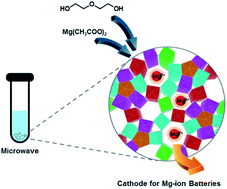Microwave-assisted chemical insertion: a rapid technique for screening cathodes for Mg-ion batteries†
Abstract
We report an ultrafast microwave-assisted solvothermal method for chemical insertion of Mg2+ ions into host materials using magnesium acetate [Mg(CH3COO)2] as a metal-ion source and diethylene glycol (DEG) as a reducing agent. For instance, up to 3 Mg ions per formula unit of a microporous host framework Mo2.5+yVO9+z could be inserted in as little as 30 min at 170–195 °C in air. This process is superior to the traditional method which involves the use of organometallic reagents, such as di-n-butylmagnesium [(C4H9)2Mg] and magnesium bis(2,6-di-tert-butylphenoxide) [Mg-(O-2,6-But2C6H3)2], and requires an inert atmosphere with extremely long reaction times. Considering the lack of robust electrolytes for Mg-ion batteries, this facile approach can be readily used as a rapid screening technique to identify potential Mg-ion electrode hosts without the necessity of fabricating electrodes and assembling electrochemical cells. Due to the mild reaction conditions, the overall structure and morphology of the Mg-ion inserted products are maintained and the compounds can be used successfully as a cathode in Mg-ion batteries. The combined synchrotron X-ray and neutron diffraction Rietveld analysis reveals the structure of the Mg-inserted compounds and gives an insight into the interactions between the Mg ions and the open-tunnel host framework.



 Please wait while we load your content...
Please wait while we load your content...